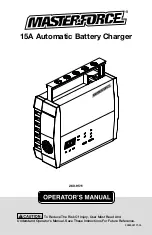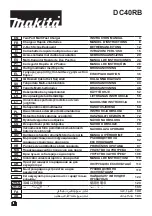
Page 9
• AGM –
The Absorbed Glass Mat con-
struction allows the electrolyte to be
suspended in close proximity with
the plate’s active material. In theory,
this enhances both the discharge and
recharge efficiency. The AGM batter-
ies are a variant of Sealed VRLA (valve
regulated lead-acid) batteries. Popular
uses include high-performance engine
starting, power sports, deep-cycle,
solar and storage batteries.
•
GEL –
The electrolyte in a GEL cell has
a silica additive that causes it to set
up or stiffen. The recharge voltages on
this type of cell are lower than those for
other styles of lead-acid battery. This is
probably the most sensitive cell in terms
of adverse reactions to overvoltage
charging. Gel batteries are best used in
VERY DEEP cycle application and may
last a bit longer in hot weather appli-
cations. If the wrong battery charger is
used on a gel cell battery, poor perfor-
mance and premature failure will result.
11. OPERATING INSTRUCTIONS
A SPARK NEAR BATTERY MAY CAUSE
AN EXPLOSION.
IMPORTANT:
Do not start the vehicle with
the charger connected to the AC outlet,
or it could damage the charger.
NOTE:
This charger is equipped with an
auto-start feature. Current will not be
supplied to the battery clamps until a bat-
tery is properly connected. The clamps
will not spark if touched together.
CHARGING A BATTERY
IN THE VEHICLE
1.
Turn off all the vehicle’s accessories.
2.
Keep the hood open.
3.
Clean the battery terminals.
4.
Place the charger on a dry, non-flam-
mable surface.
5.
Lay the AC/DC cables away from any
fan blades, belts, pulleys and other
moving parts.
6.
Connect the battery, following the pre-
cautions listed in sections 6 and 7.
7.
Connect the charger to an electrical
outlet.
8.
Select the battery type and charge rate.
9.
When charging is complete, disconnect
the charger from the AC power, remove
the clamps from the vehicle’s chassis,
and then remove the clamp from the
battery terminal.
CHARGING A BATTERY
OUTSIDE OF THE VEHICLE
1.
Place battery in a well-ventilated area.
2.
Clean the battery terminals.
3.
Connect the battery, following the pre-
cautions listed in sections 6 and 7.
4.
Connect the charger to the electrical
outlet.
5.
Select the battery type and charge
rate.
6.
When charging is complete, discon-
nect the charger from the AC power,
disconnect the negative clamp, and
finally the positive clamp.
7.
A marine (boat) battery must be
removed and charged on shore.
CHARGE RATE
The charger will automatically adjust the
charging current, based on battery size,
in order to charge the battery completely,
efficiently and safely.
BATTERY CHARGING TIMES
Times are based on a 50% discharged battery
and may change, depending on age and con-
dition of battery.
Summary of Contents for 260-9511
Page 14: ...Page 14 NOTES ...
Page 15: ...Page 15 NOTES ...
Page 16: ... 2020 Menard Inc Eau Claire WI 54703 03 2020 ...


































